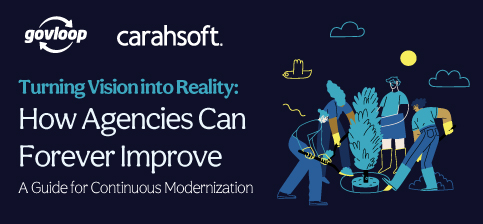In the past two years, agencies have taken a hard look in the mirror. Often on short deadlines, they had to stand up new IT systems, design innovative customer experiences, collect and manage hordes of data, provide tools for a newly remote workforce, and evaluate funding and other resources. Some agencies managed with what they had; others were exceptionally ill-prepared. The immediate challenge was a health care crisis that had overwhelmed much of society. But now that we’ve entered what’s known as the post-peak phase of the pandemic, it’s time for agencies to consider, “What next?” The purpose of this guide is not to help organizations prepare for the next disaster. The purpose is to go beyond that — to explore how agencies can take a broader, more overarching and continuous approach to self-improvement. Download the guide to read more about how to institute continuous modernization to exceed your goals.
Digital Transformation Starts with Strategy
“For many people, the first and only interactions they have with a government agency are through its website, and good first impressions can go a long way. It’s not just having an exciting color palette, cool graphics and boxes that flip over when you hover your cursor on them. It’s about building a site, a platform, that appeals to and serves the public and is intuitive, quick and secure. It needs to highlight the work an agency does, the services it offers consumers and the resources it makes available.”
Read more insights from Mobomo’s Chief Executive Officer, Brian Lacey.
Videoconferencing: Modernizing How Employees Connect and Collaborate
“At the intersection of all the types of reforms we cover in this guide — people, technology, innovations and budgets — lies one that has reimagined what it means to communicate: videoconferencing. Indeed, when agency offices temporarily closed nearly two years ago, employees who knew little about their laptop cameras suddenly became webinar proficionados. They scheduled video meetings, learned to read body language from the chest up, and got a peek into coworkers’ home lives. And many agencies discovered that video technology not only made remote work a viable long-term option, but it allowed organizations to expand their customer services in a forward-looking, energized way — akin to what the private sector often provides.”
Read more insights from Zoom’s SLG Industry Marketing Manager, Elijo “Leo” Martinez.
How to Cross the Analytic Divide and Democratize Data
“In one of America’s largest counties, a public health agency struggled with collecting and interpreting COVID-19 test results quickly and accurately because of data quality issues requiring hours of manual review. Analytic automation made a difference. This technology unified processes across analytics workflows by analyzing data quality and format before notifying relevant parties about potential compliance issues. Ultimately, analytic automation saved the agency five full-time equivalent employees manually reviewing data quality and notifying reporting labs about errors in this information. Reducing the amount of manual labor also accelerated the time needed to map COVID-19’s spread and address related public health challenges.”
Read more insights from Alteryx’s Director of Solutions Marketing, Public Sector, Andy MacIsaac.
 Are People at the Center of Your Modernization Efforts?
Are People at the Center of Your Modernization Efforts?
“Agencies have to be mindful of the narrative that people believe about the nature of government work. They must be skilled at cutting through the noise and using language that speaks to the heart of what government does and why that work is critical. ‘Government matters, and we have seen that very dramatically for the past two years,’ Heimbrock said. ‘Not only is government’s ability to respond to crises the difference between people living and dying, but our government institutions are under attack.’ Agencies can’t afford to be stymied by bureaucratic entanglements and dated technologies, which are steep prices of not paying attention to modernization.”
Read more insights from Qualtrics’ Chief Industry Advisor for Government, Sydney Heimbrock, Ph.D.
Making a Case for Continuous Improvement
“Home improvement shows are something of a metaphor for government modernization. You can superficially update an old home for quick sale and profit, or you can do more intensive and long-term improvements that require additional time, talent and, of course, money. And as outdated as the home may look, it’s worth remembering it probably was impressive in its day — kind of like the bygone technology that still supports many government agencies. That’s the parallel Brandon Shopp with SolarWinds drew when asked about the need for continuous agency modernization. ‘Technology is evolving constantly,’ he said, ‘and so unless you want to end up with something like a house that looks very dated and old, you need to stay on top of things.’”
Read more insights from SolarWinds’ Group Vice President of Product, Brandon Shopp.
USAID Learns New Tricks of Training Trade
“Officials at the U.S. Agency for International Development (USAID) were on a path to harmonizing numerous data-related training when COVID-19 made virtual work a necessity. For USAID, this proved the perfect opportunity to roll out a training curriculum that worked for employees who were working remotely. Before the pandemic, USAID leaned heavily on classroom-based instruction. In exploring options for virtual training, it recognized an opportunity to rethink instructional design, said Julie Warner Packett, a Data Scientist at USAID who helps lead training on data use and governance.”
Read more insights from USAID’s Data Scientist, Julie Warner Packett.
A Federal Vision for Enterprisewide IT
“The state of Connecticut has launched a new “Information Technology Optimization Process” to replace the state’s disparate approach to agency IT. The yearlong initiative aims to deliver coordinated, modern solutions for agencies and the public alike — and recognizes that nearly 50% of the state’s IT workforce is older than 55. The new strategy has three overarching goals to improve state operations now and into the future. First, the plan aims to optimize existing technology by completely rethinking the structure of Connecticut’ IT delivery system. Second, the plan will accelerate efforts to deliver more digital government services. Using enterprise technology, officials aim to hide the “seams” between agency operations and user interactions. And third, the state will enhance its cybersecurity protections.”
Read more insights from OPM’s Chief Information Officer, Guy Cavallo.
Empowering Frontline Employees to Lead a Culture of Innovation
“Within the Veterans Affairs Department (VA), the Veterans Health Administration’s Innovators Network (iNET) stands out as a leader for several reasons. High on that list is the reality that innovation is just as much a mindset as it is concrete actions, and Allison Amrhein, Director of Operations for iNET, has the kind of growth mindset that’s needed to sustain and expand new ways of working. The program launched in 2015 in response to VA’s annual employee survey, which found that some employees did not feel encouraged to try new things at work. Today, the program operates across 34 VHA sites, but all sites may participate.”
Read more insights from iNet Director of Operations, Allison Amrhein.
Wayne County Is Making Funding Last
“After Superstorm Sandy in 2012, New York City received Community Development Block Grant funding from the federal government to help rebuild storm-ravaged neighborhoods. Nearly a decade later, many of those projects — and the contracts that support them — are still going strong, said Rachel Laiserin, Chief Financial Officer of the city’s Department of Design and Construction. The key to those projects’ success has been a commitment to including contracting officers, procurement staff, legal teams and finance team members early in the process and maintaining a long-term perspective.”
Read more insights from Wayne County Michigan’s Chief Financial Officer, Hughey Newsome.
Download the full GovLoop Guide for more insights from these modernization thought leaders and additional government interviews, historical perspectives and industry research on the future of modernization.







